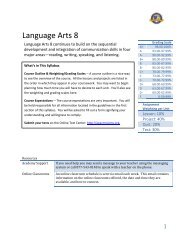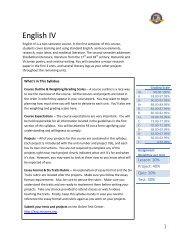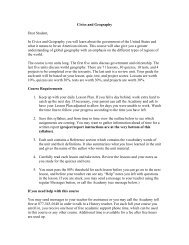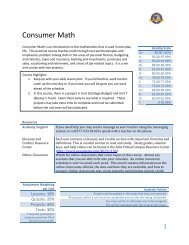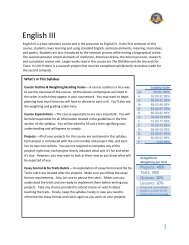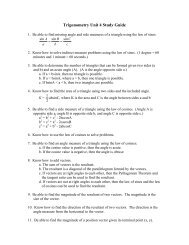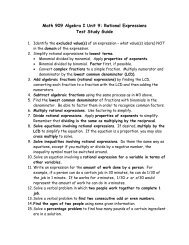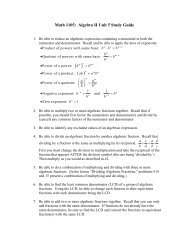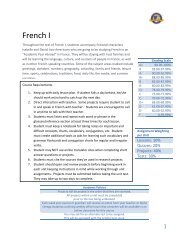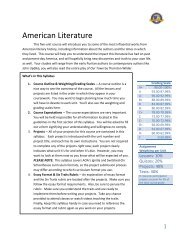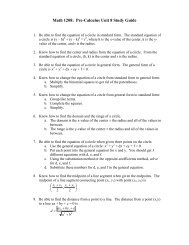Math 1108: Algebra II Unit 8 Study Guide
Math 1108: Algebra II Unit 8 Study Guide
Math 1108: Algebra II Unit 8 Study Guide
- No tags were found...
You also want an ePaper? Increase the reach of your titles
YUMPU automatically turns print PDFs into web optimized ePapers that Google loves.
<strong>Math</strong> <strong>1108</strong>: <strong>Algebra</strong> <strong>II</strong> <strong>Unit</strong> 8 <strong>Study</strong> <strong>Guide</strong>1. Know and be able to apply the rules of exponents.•0Zero exponent: If b≠ 0, then b = 1• Negative exponent:−n1 1If n is an integer and b≠0, then b = andn−nb b= b•m nMultiplying like bases: b ⋅ bm n= b +m• Raising a base to another power: ( ) n m nb = b ⋅mb m−n• Dividing like bases: If b≠ 0, then = bnb• Raising a product to a power: ( ab ⋅ ) n = a n ⋅ b⎛a⎞ a• Raising a quotient to a power: ⎜ ⎟ =⎝b⎠bmn n m n• Fractional exponents: a a ( a)nnnm= = andnnm pn m p n na ⋅ b = a ⋅ b2. Use the rules of exponents to simplify a numerical or algebraic expression.3. Be able to rewrite an algebraic expression without negative exponents.4. Simplify a numerical expression that has fractional exponents.5. Be able to rewrite a radical expression as an algebraic expression with fractionalexponents. Also, be able to rewrite an expression containing fractional exponentsas a radical expression.6. Be able to simplify a radical expression of the form n amrelatively prime, then the expression is simplified, e.g.,. Note: If m and n are6 29 6 9 3 3 2z = z = z = z .7. Recall that no real solution exists for an even root of a negative number,e.g. 4 − 16 .8. Review how to simplify a radical expression by rationalizing the denominator.9. Be able to solve an exponential equation of the form mx n b+a = , where a, b, m, andn are constants. One way is to convert both sides to have the same base. Onceeach side has the same base, you can set the exponents equal to each other andsolve for x.
10. Given an exponential function, be able to find the corresponding y-values for x-values that are provided. Be able to plot these coordinate points in a coordinateplane.11. Know the conversion for an exponential equation to a logarithmic equation, e.g.,xy = a ⇔ x= log y. Note: These are inverse functions.a12. Be able to write a logarithmic equation in its equivalent exponential form. Also,be able to write an exponential equation in logarithmic form.13. Be able to evaluate a logarithmic expression by writing it as an exponentialexpression. Recall that you can first set the expression equal to a variable andthen convert to an exponential expression.14. For example, if given log636 , set it equal to a variable, log636 = x , convert to anexponential expression, 6 x = 36, and solve for the variable:xx 26 = 36 ⇒ 6 = 6 ⇒ x = 2 ⇒ log 36 = 2.15. Know and be able to apply the properties of logarithms:• logb 1 = 0 , for any base b.• log b1, for any base b.• logb( mn) = logbm + logbn• log mb⎜⎟ = logbmlogbn⎝ n ⎠• logkm = klogmbb616. Know that the base 10 log is referred to as the common logarithm. If a logarithmis written without a base, it is assumed to be a common logarithm, i.e., havingbase 10.17. Be able to express a number in scientific notation.18. Know how to use the table of common logarithms to find the common logarithmicvalue of a number. Recall that the table lists values for numbers only between1.00 and 9.99.19. Be able to find the “mantissa + characteristic” form of a common logarithmicvalue of a number. Recall that you must first put the number in scientific notationand then use the logarithmic properties to evaluate. For example:−4 −4log 0.000752 = log 7.52× 10 = log 7.52 + log10 = log 7.52 + ( −4)log10( )= log 7.52 + ( − 4) = 0.8762 + ( −4)
20. Be able to evaluate a logarithmic expression by using a calculator or the table ofcommon logarithms.21. Be able to find the antilog value of a number by first putting it in “mantissa +characteristic” form. Then set this equal to a variable and solve using logarithmicproperties. For example, if given antilog(6.8762 − 10) , we must first changeto antilog(0.8762 − 4) because 6− 10=− 4.N = anti log(6.8762 −10)N = antilog(0.8762 −4) ⇒ log N = 0.8762 −4−4log N = log 7.52 + log10−4log N = log(7.52×10 )N = 0.000752Note: The antilog function is the inverse of the common logarithm function. It( 0.8762−4)could also be expressed as N = 10 .22. Using a calculator or the table of common algorithms, be able to evaluate anantilog expression, e.g., a ntilog(2.8531) . If using the table, you must first put thevalue in “mantissa + characteristic” form.23. Given a logarithmic function, be able to find the corresponding y-values for x-values that are provided. Be able to plot these coordinate points in a coordinateplane.24. Be able to apply the logarithmic properties to logarithmic expressions in base e,2e.g., logee= 2logee= 2⋅1 = 2 . Note: e represents the irrational number2.71828... , which has many applications in higher-level mathematics as well asscience. In mathematics, log eis usually written instead as"ln".25. Be able to use the matrix method to solve a system of linear equations.26. Be able to add two matrices together where both have the same dimensions, e.g.,both are 3-by-3.27. Be able to multiply two matrices together. Recall that; e.g., 2-by-2 multiplied by2-by-3. In general, if A and B are matrices, their product, C, would beAmxn ⋅ Bnxp = Cmxp. The number of columns in the first matrix must equal thenumber of rows in the second matrix. Also, the product matrix will have the samenumber of rows as A, and the same number of columns as B.



